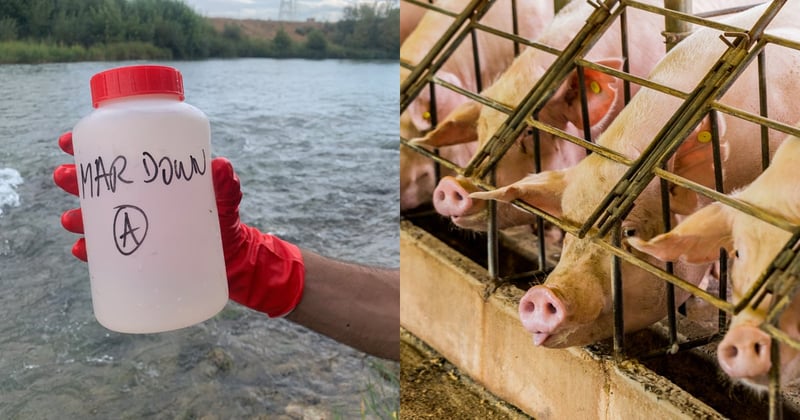
Groundbreaking testing by World Animal Protection documents antibiotic resistance elements in waters and soils near factory pig farms in four different countries, providing further evidence of factory farming’s contribution to an ongoing global public health crisis.
Positive findings of several antibiotic resistance genes (ARG) of concern in the environment near to factory farms—where farmed animals suffer in crowded, barren conditions—suggests that the routine use of antibiotics to prop up low-welfare practices on these farms is likely posing a risk to public health.
Our investigations in the US, Canada, Spain, and Thailand found ARGs resistant to antibiotics which are of most concern to the World Health Organization (WHO). ARGs are the building blocks of antibiotic-resistant bacteria, or “superbugs,” that can occur naturally but are increasingly prolific due to antibiotic overuse.
Factory farms pack animals tightly together in barren pens or cages to maximize space. They are bred for rapid growth rates and fed high-energy diets to further speed up weight gain. Their genetic uniformity, cramped conditions, and propensity for injuries make them highly susceptible to diseases and infections that emerge and can spread quickly through a barn or feedlot.
It is unsurprising, then, that the growth and expansion of factory farming in the US has coincided with increased use of veterinary antibiotics. In addition to relying on antibiotics to treat animals should they get sick, antibiotics are routinely administered via feed, water, and injection to entire groups of animals housed together as a strategy to keep them from getting sick in such conditions—called “disease prevention” or “prophylactic” use.
Superbugs do not remain on the farm but are carried away on the animals, workers, insects, rodents, air, and waste. Factory farms generate large quantities of animal waste, which is often spread on land for use as a fertilizer or discharged into public waterways. It can also seep into groundwater. Waterways can be flashpoints for toxic pollutants and create reservoirs where superbugs accumulate and mix.
In the US, water and soil samples were collected on public lands near to factory farms in North Carolina, a state with roughly 2,200 pig producers operating today. Our testing found:
- All samples tested returned a positive result for at least 1 resistance gene.
- 92% of samples had positive PCR results for 3 or more resistance genes, with the largest number of genes in a single sample being 10.
- Genes conferring resistance to tetracyclines were identified in 99% of samples, with roughly half of the samples positive for 3 or more tetracycline-resistance genes. Available data indicate widespread use of tetracyclines (categorized as highly important by the World Health Organization (WHO)) by the US pork industry.
- There were notable differences in samples taken downstream from the target farms, which are more likely to be directly impacted by the farms’ operations, emissions, and discharges, including genes for streptomycin- and macrolide-resistance (both categorized as critically important) being found predominantly in downstream samples only.
The superbug crisis poses a threat that could eclipse the COVID-19 pandemic. Already, more than 700,000 people die each year from superbugs where antibiotics are ineffective in treating infections.
Alarmingly, up to 10 million people are expected to die from superbugs each year by 2050. The WHO recommends that antibiotics should not be routinely used to prevent disease across groups of farmed animals. These antibiotics are the last line of defense to keep patients alive when other treatment for conditions like respiratory infections has failed.
Despite this, the Food and Drug Administration (FDA) has done little to address routine, unnecessary antibiotics use in farmed animals. As early as the 1970s FDA signaled an intent to restrict the use of important antibiotics in farmed animals for uses other than to treat an infection, targeting both growth promotion uses (now effectively banned), and disease prevention uses (still allowed). The agency’s plans to restrict disease prevention were stopped by industry pressure on Congress.
As such, use in farmed animals in the US remains high. Data from 2016 show that 95% of US swine operations used antimicrobials in their production, and 90% of sites administered medically-important antibiotics via feed or water. Producers were also likely to administer several different antibiotics to their pigs. Annual data published by FDA show that the pork industry continues to be one of the largest markets for antibiotics in the US.